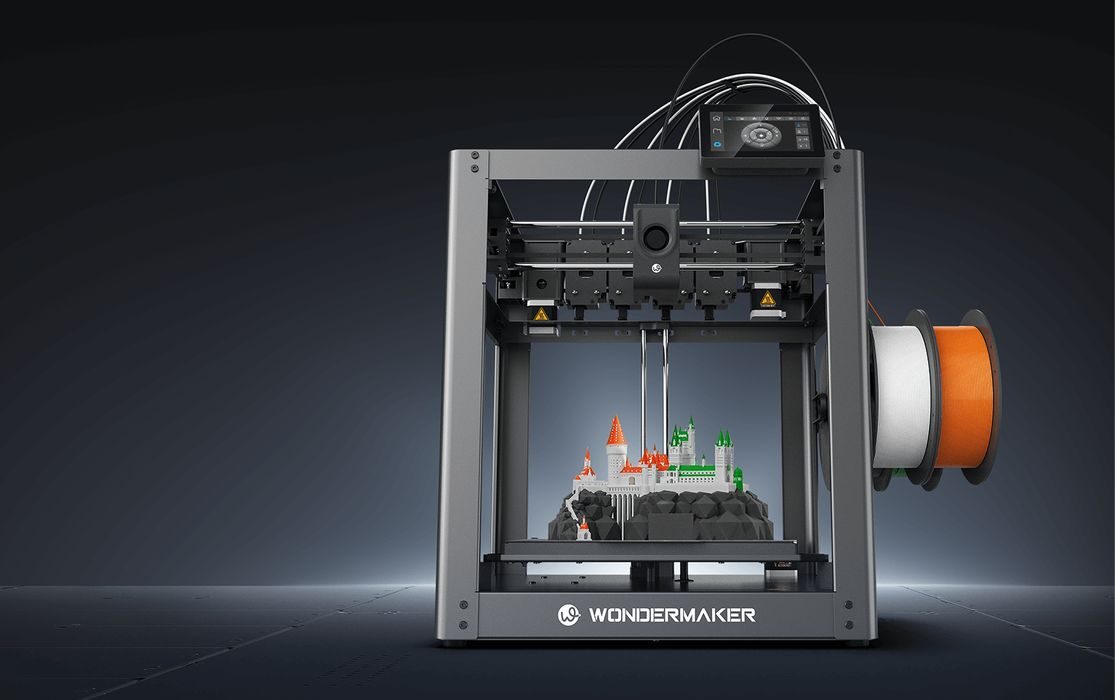
There’s a new toolchanging 3D printer coming soon, the WonderMaker ZR series.
You may not have heard of WonderMaker. I had not either. It’s a very new Chinese 3D printer manufacturer that doesn’t seem to say a lot about themselves. I did notice their domain name was registered only on December 5, 2024 — only four months ago.
Their only products are the ZR and ZR Ultra 3D printers, with the Ultra being the toolchanger. The remaining specifications for the two printer models are the same, and let’s take a look at the key statistics:
- Build volume: 300 x 300 x 300 (slightly smaller with the Ultra)
- Hot end maximum temperature: 300°C
- CF-compatible nozzles
- Build plate maximum temperature: 100°C
- Maximum travel speed: 600mm/s
- Maximum volumetric flow rate: 32 cubic mm/s
- Nozzle diameters available: 0.2, 0.4, 0.6, 0.8 mm
- Magnetic PEI-coated build plate
- Automatic levelling
- Filament detection
- Klipper firmware and high-speed printing
- Power off detection and recovery
- WiFi network
- Quiet operation
- Color touchscreen
There are a couple of options:
- Full enclosure (US$99)
- Onboard camera (?)
- Auxiliary cooling fan (?)
Software for the ZR series is a modified version of the popular OrcaSlicer tool.
The base ZR system seems to be a reasonable set of features that would be competitive in today’s fully-enclosed desktop 3D printer market. However, the really interesting part is the toolchanging capability that comes with the ZR Ultra version.
The ZR Ultra model includes four toolheads, each of which can be loaded with a different filament — and instantly ready to go during printing. WonderMaker said the switch time is only four seconds, which is enormously faster than the typical “pull it out and reinsert filament” approach used by most multimaterial 3D printers these days.
The toolchanging approach also enables the use of flexible TPU filament in multimaterial print jobs. This is impossible with the other multimaterial approach because the wet spaghetti-like flexible filament cannot be reliably pulled and pushed in PTFE tubes. In other words, you can print a rubbery grip on that 3D-printed toothbrush.
Toolchanging 3D printers have typically been quite expensive, and that’s not surprising: they involve more hardware than single extruder machines. There aren’t a lot of them on the market today, as several seem to have disappeared over the past few years, likely due to the extra expense and competition from the less expensive multimaterial options.
The most prominent toolchanger on the market today is Prusa Research’s XL. This popular device has a bigger build volume than the ZR Ultra and offers five toolheads, not four. However, it’s priced at US$3499 — out of the range of many prosumer-level operators.
This made me very curious about the ZR Ultra’s price. It turns out the ZR Ultra will be priced at only US$549, plus US$99 for the enclosure.
That is substantially less expensive than the Prusa XL, over 5X less expensive. This device, if it lives up to the promises made in their marketing material, could pose a big challenge for Prusa Research.
However, the ZR Ultra is not yet available. The company’s plan is to do some marketing (now) and then open up orders via a Kickstarter campaign this month. They don’t say when they will ship the machine, but it will certainly be after the campaign closes in May.
I’m wondering how WonderMaker is able to lower the cost of a toolchanger so low? It’s very hard to tell from the material released so far, so we’re going to have to wait until some review units get out to the public.
Via WonderMaker

